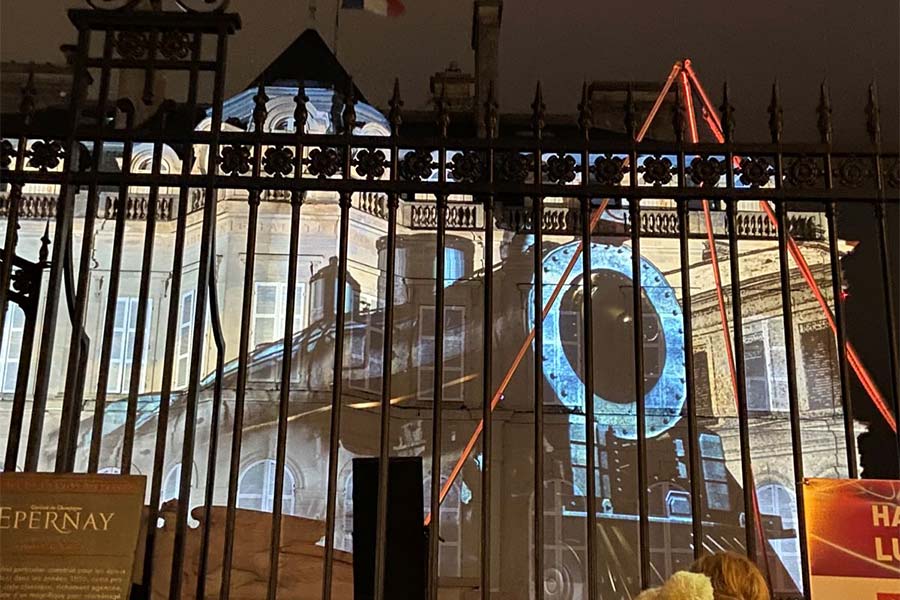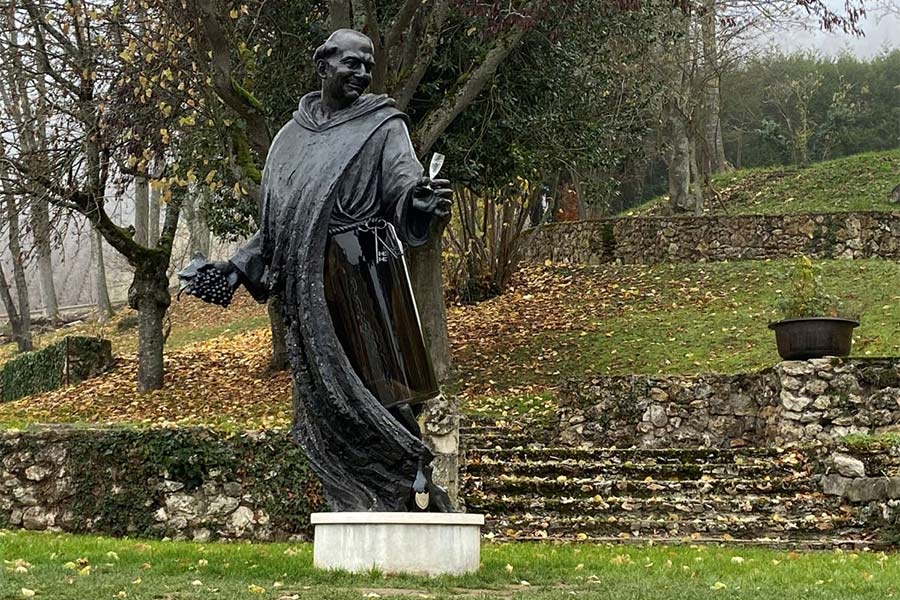Mary Anne Evans is dazzled!
The Avenue de Champagne shone with thousands of glittering lights, the façades of the elegant great champagne houses illuminated with a rich mix of bright colours. It was the opening night of the annual Les Habits de Lumières weekend. Always held on the second weekend in December and famous in France, it’s almost completely unknown outside the country. And that’s a shame as this is one heck of a party. It was not what I had expected at all.
The champagne houses had opened their courtyards and doors to the public. An acrobat performed gravity-defying feats in the grounds of one; in others small trucks served food and an astonishing amount of their own champagne while entertaining onlookers with some pretty heavy rock music. Pol Roger had a silent disco for 600. A group of performers dressed in bizarre costumes that flashed different colours made their slow way up the Avenue scattering the crowds. This was to celebrate champagne? The most aristocrat of drinks? This was pure unadulterated fun.


On Saturday morning Les Habits de Saveurs showcases regional Michelin-starred chefs who demonstrate their skills in front of a formidable French crowd. After each session, bite-sized versions of their dishes are handed around. You can wash it down, of course, with a glass of bubbly. And it’s all free.
On Sunday hundreds of vintage cars and vans make their stately – and sometimes disastrous – way through the streets.
I was there for the weekend, but Épernay is a great place to visit at any time of the year. Nearby Reims (26km north) might be better known, but I found Épernay, set among rolling, vine-covered slopes, more beautiful and a better introduction to the great drink.
A cellar visit is a must. We went to Moët et Chandon, the largest and most prestigious champagne house on the Avenue called by Winston Churchill as ‘the most drinkable street in the world’. Walking through the underground darkened cellars full of that expensive drink with a guide who gave us an insight into the time-consuming process was just the right introduction to…yet another glass of their superb bubbly upstairs.
No bubbly at the Champagne Wine and Regional Archaeology Museum. Housed in the gracious former Château Perrier, the museum covers a lot and does it in small digestible clumps. I left the geology and archaeology sections to others and went up to the rooms of human history which have delightful models and artefacts (as well as games like putting a broken Roman vase together).


A visit to Pressoria in nearby Aÿ-Champagne was revelatory. It’s an informal but informative introduction to the soil, the vines, the weather and the seasons. And it’s fun. Vine roots snaking across a floor follow your footsteps as the ground wakes up after winter; you sniff different scents and try to identify them (harder than I had imagined); you touch, listen and finally of course you taste some of the bubbly.
You can’t visit Champagne without greeting Dom Perignon, the Benedictine monk who did not invent the drink as is commonly believed. But the redoubtable cellar master did pioneer some of the key elements in making the drink, back in the 1670s in Hautvillers.
The pretty small village is something of a pilgrimage. Walk along the road to the ancient Abbey which looks out over the surrounding UNESCO World Heritage site vineyards. Inside I paid brief homage at the tomb of Dom Perignon. His serious statue is in Moët & Chandon’s courtyard in Épernay. His more popular one is on a small village green in Hautvillers. The upper part of his body is a straightforward statue; the bottom is half a Champagne bottle and Dom Perignon looks very happy.

On our final day my vintage tour company took us in a 70’s Estafette minibus to a vineyard where the art of sabring a bottle of champagne was revealed in all its glory. It’s relatively easy to behead the top of the champagne bottle with a small sharp sabre if you get the details right. But I am hesitating at trying it back home.
Épernay is easy to get to – a 90-minute journey from Paris by train or a 3 hour drive from Calais. As short breaks go this charming city that is the real capital of Champagne takes a lot of beating.
Next Steps
Our Silver Travel Advisors can help plan your perfect French trip itinerary. Call our travel experts: 0800 412 5678.
Where to Stay and Eat in Épernay
I stayed at Vertus, just outside Épernay in the Best Western Le Relais du Vigneron. Modern, comfortable and just a short ride into Épernay.
Recommended restaurants:
Le Domaine de Vincene: Small family-run restaurant with excellent food using local ingredients.
La Table Kobus: Brasserie-type decoration with top food and my favourite.
Royal Champagne: Michelin one-starred restaurant in beautifully rebuilt hotel overlooking vineyards.
Château d’Étoges: Impressive château just outside Épernay.











